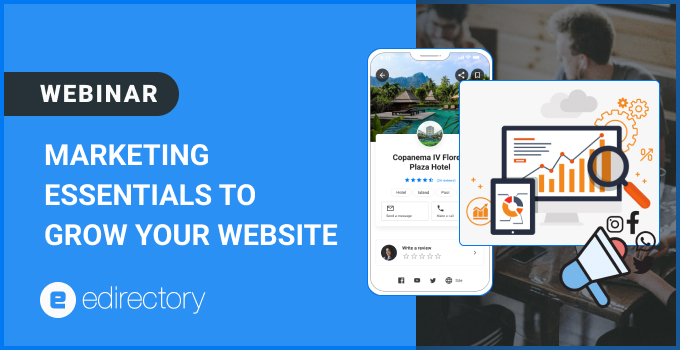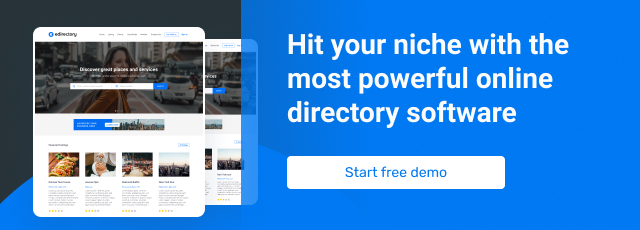
Creating an online directory has become easier than ever, but it is one thing, and seeing it thriving is another very different situation. The goal of every online business, whether it is an online directory website, membership platform, or online, is financial success. Still, to reach your goals, strategy plays a huge part in where your project will be in the future. In this webinar, we delve into the marketing essentials to grow your website or online directory by applying tried and true methods that can improve your chances of success. Let’s dive right into it.
1. Decide Your Short and Long-Term Goals
The first step to any successful marketing strategy is setting clear goals.
Why is this so important? A focused goal gives you direction. It tells you where to invest your time and resources to achieve measurable success.
Examples of Common Goals
For online directories, common goals might include:
- Increasing website traffic
- Boosting user registrations
- Growing paid memberships
But having a goal isn’t enough—it needs to be actionable.
Creating Actionable Goals
Break larger objectives into smaller, achievable steps.
For example, if your goal is to increase traffic by 20%, you can create a plan like:
- Optimize content for SEO.
- Run targeted ad campaigns.
- Post regularly on social media.
Choosing a Timeframe
Deadlines are critical to track progress.
- Short-term goals, like launching a new campaign, might cover 1–3 months.
- Long-term goals can span 6 months to a year, like achieving a specific revenue milestone.
Ask yourself: “What do I want to achieve this month? This year?” Then work backward to map out your steps.
2. Conduct Market Research
Before executing any strategy, you need to understand the market you’re competing in.
Why Market Research Matters
Market research helps you:
- Understand your niche
- Identify trends
- Recognize your competitors’ strengths and weaknesses
Steps to Conduct Market Research
- Analyze your competitors’ directories: What features do they offer? How do they price their services?
- Gather insights from your audience: Use surveys, social media polls, or interviews to learn their needs and pain points.
Using Data to Inform Decisions
Use tools like Google Analytics and keyword research platforms to identify what your audience is searching for.
- Which categories or topics are in demand?
- Are there underserved areas you can capitalize on?
The data you collect will help you make informed decisions about your strategy.
Webinar: Marketing Essentials to Grow Your Website
3. Building Your Marketing Strategy
Branding and Brand Positioning
Start by defining your Unique Value Proposition (UVP). Ask yourself:
- What makes my directory stand out?
- Why should users choose my platform over others?
Ensure consistency in your design, tone, and messaging across all channels to build trust with your audience.
Target Audience
Get to know your audience by creating detailed personas.
- What are their demographics?
- What problems are they looking to solve?
Segment your audience for personalized marketing campaigns.
Marketing and Social Media Channels
Choose the right channels based on your audience’s preferences:
- LinkedIn might work for professional directories.
- Instagram or Facebook could be ideal for lifestyle-focused directories.
Use a mix of organic strategies like SEO and content marketing, alongside paid efforts like Google Ads or retargeting campaigns.
Don’t forget to explore partnerships and collaborations to expand your reach.
4. Test, Analyze, Adjust, Repeat
Tools for Testing and Analyzing
Track key metrics like traffic, bounce rate, and conversions using tools like Google Analytics or Hotjar.
How to Adjust Your Strategy
The first version of your strategy won’t be perfect—and that’s okay!
Analyze your data and make adjustments.
For example:
- If a campaign isn’t converting, refine your targeting or improve your call-to-action.
- If users are leaving your site quickly, optimize your landing page experience.
Marketing is a process of continuous improvement.
5. Marketing Your Directory Website
Strategies for Growth
- Content Marketing: Publish blog posts, guides, or case studies relevant to your audience.
- Email Marketing: Build a subscriber list and send regular, valuable updates.
- Community Engagement: Foster relationships through forums or social media platforms.
Paid Advertising
Use targeted ads to reach specific audiences and retarget visitors who didn’t convert on their first visit.
SEO Optimization
Optimize your directory’s categories and listings for search engines.
Don’t overlook the power of backlinks and local SEO if you serve a regional audience.
6. Conclusion
Recap of Key Takeaways
- Clear goals and thorough market research lay the foundation for success.
- A strong brand and targeted strategy drive growth.
- Constant testing and adjustments ensure your strategy evolves with your audience’s needs.
Encourage Next Steps
Start small. Test different strategies. Learn what works, and scale from there.
Call to Action
If you’re looking for tools to simplify your directory management and marketing, I encourage you to check out eDirectory. We’re here to help you succeed.
USEFUL LINKS AND TOOLS MENTIONED IN THE WEBINAR:
*We are not affiliated, associated, authorized, endorsed by, or in any way officially connected to the tools and sites mentioned in the webinar.
This session was recorded on December 19th, 2024.
- Don’t forget to register for eDirectory’s next Webinar.
- Do you want to know what eDirectory can do for you? Sign up for a free guided Demo here.
Want more tips? Send us a note at marketing@eDirectory.com.


